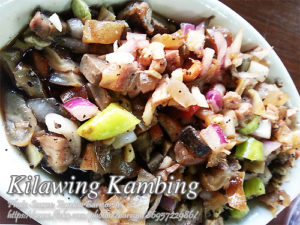This kinilaw na tababa dish is I think the simplest and easiest way to prepare oysters. Provided that you bought the oysters already shucked so you won’t have to do the hard and dirty work. That is one of the hardest part in preparing oysters. Kinilaw is also known as ceviche or soaking the fish or seafood in vinegar or lime to pickle it. Then you put spices to make the dish more appetizing. Actually kinilaw should be eaten raw and without heating it but there are also some who prefer to cook it for a few seconds or minutes. This method is preferable to people who can’t tolerate eating raw fish or seafood.
Oysters ceviche is a delightful Filipino dish that showcases the freshness of seafood. This dish is a testament to the Filipino love for bold flavors and fresh ingredients. Let’s explore the simplicity and rich flavors of this oyster delicacy.
The Art of Kinilaw
Kinilaw, also known as ceviche, is a method of pickling fish or seafood in vinegar or lime juice. This process “cooks” the seafood without heat, resulting in a dish that is both flavorful and refreshing. Kinilaw is a popular dish in the Philippines, often served as an appetizer or pulutan (beer match).
The History Behind Kinilaw
Kinilaw has a long history in Filipino cuisine, with some tracing its origins back to pre-colonial times. The method of cooking seafood with vinegar or lime juice was likely influenced by early Chinese and Spanish traders who introduced vinegar to the Philippines. Over time, the dish evolved to incorporate local flavors and ingredients, becoming the Kinilaw we know today.
Preparing Oysters
To make the ceviche, start by slicing onions into thin rings. In a bowl, combine garlic, salt, and pepper with vinegar. Add the shucked oysters to the vinegar mixture and let it stand for 2 to 3 hours. Some prefer to let it marinate longer for a more intense flavor.
Serving Kinilaw na Talaba
After marinating, you have two options for serving it. You can serve it with the vinegar mixture, which adds a tangy flavor to the dish. Alternatively, you can drain the oysters before serving, allowing the flavors of the seafood to shine through.
Food for Thought
Kinilaw na talaba is more than just a dish; it’s a celebration of Filipino culture and flavors. The simplicity of the ingredients and the boldness of the flavors make it a standout dish in Filipino cuisine. So, the next time you’re looking for a fresh and flavorful seafood dish, consider trying it.
How to Make Kinilaw na Talaba (Oysters Ceviche)
Ingredients
- 1 cup fresh oysters
- 1/2 cup vinegar
- 3 cloves garlic crushed
- 5 small red onions or native onions
- 1/2 tsp. peppercorns coarsely ground or pounded
- 1/2 tsp. salt
Instructions
How to make Kinilaw na Talaba:
- Slice onions into thin rings. Add garlic, salt and pepper to vinegar.
- Add oysters. Let stand for 2 to 3 hours.
- If you are planning to serve it 5 hours later or more.
- Boil the kilawin over high heat for a few seconds and remove immediately or it will be reduced to the size of a pea.
- You could serve it with the vinegar mixture or drain the oysters and serve.
Notes
Cooking Tips:
1. Choosing the Freshest Oysters Select oysters that are tightly closed or slightly open; avoid those with wide openings, as they may be dead and unsafe to eat. Fresh oysters should smell like the ocean, with no strong or off-putting odors. When shucking oysters, discard any that are already open before shucking, as they may be spoiled. 2. Properly Shucking Oysters Use a sturdy oyster knife to safely open the oysters. Insert the knife into the hinge of the oyster and twist it to pry the shell open. Slide the knife along the top shell to detach the oyster, then remove any shell fragments. Be cautious not to spill the oyster's juices, as they add flavor to the dish. 3. Marinating for Optimal Flavor Allow the oysters to marinate in the vinegar mixture for at least 2 to 3 hours, or longer for a more intense flavor. Refrigerate the marinating oysters to keep them fresh. If marinating for an extended period, check the oysters periodically for any signs of spoilage and discard if necessary.





